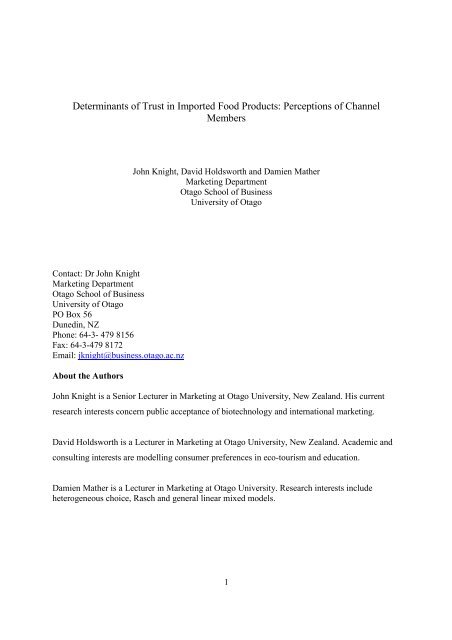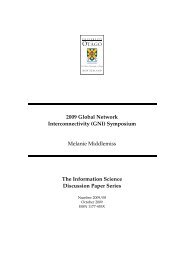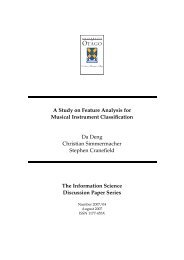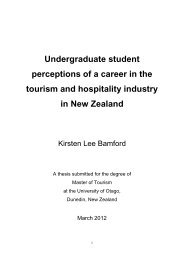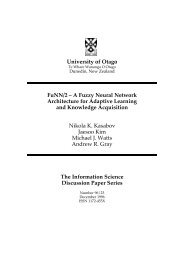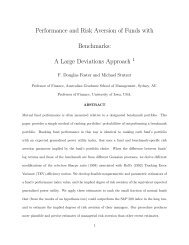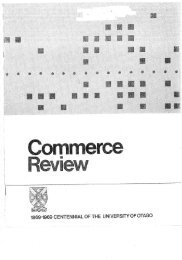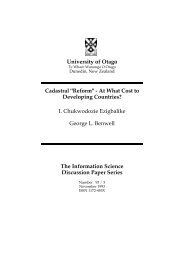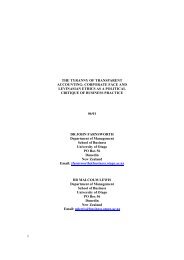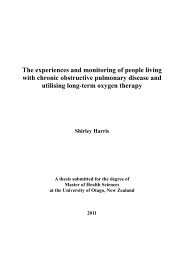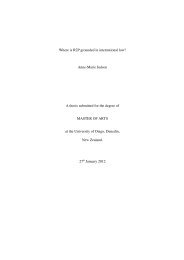Determinants of Trust in Imported Food Products - Otago University ...
Determinants of Trust in Imported Food Products - Otago University ...
Determinants of Trust in Imported Food Products - Otago University ...
You also want an ePaper? Increase the reach of your titles
YUMPU automatically turns print PDFs into web optimized ePapers that Google loves.
<strong>Determ<strong>in</strong>ants</strong> <strong>of</strong> <strong>Trust</strong> <strong>in</strong> <strong>Imported</strong> <strong>Food</strong> <strong>Products</strong>: Perceptions <strong>of</strong> ChannelMembersJohn Knight, David Holdsworth and Damien MatherMarket<strong>in</strong>g Department<strong>Otago</strong> School <strong>of</strong> Bus<strong>in</strong>ess<strong>University</strong> <strong>of</strong> <strong>Otago</strong>Contact: Dr John KnightMarket<strong>in</strong>g Department<strong>Otago</strong> School <strong>of</strong> Bus<strong>in</strong>ess<strong>University</strong> <strong>of</strong> <strong>Otago</strong>PO Box 56Duned<strong>in</strong>, NZPhone: 64-3- 479 8156Fax: 64-3-479 8172Email: jknight@bus<strong>in</strong>ess.otago.ac.nzAbout the AuthorsJohn Knight is a Senior Lecturer <strong>in</strong> Market<strong>in</strong>g at <strong>Otago</strong> <strong>University</strong>, New Zealand. His currentresearch <strong>in</strong>terests concern public acceptance <strong>of</strong> biotechnology and <strong>in</strong>ternational market<strong>in</strong>g.David Holdsworth is a Lecturer <strong>in</strong> Market<strong>in</strong>g at <strong>Otago</strong> <strong>University</strong>, New Zealand. Academic andconsult<strong>in</strong>g <strong>in</strong>terests are modell<strong>in</strong>g consumer preferences <strong>in</strong> eco-tourism and education.Damien Mather is a Lecturer <strong>in</strong> Market<strong>in</strong>g at <strong>Otago</strong> <strong>University</strong>. Research <strong>in</strong>terests <strong>in</strong>cludeheterogeneous choice, Rasch and general l<strong>in</strong>ear mixed models.1
<strong>Determ<strong>in</strong>ants</strong> <strong>of</strong> <strong>Trust</strong> <strong>in</strong> <strong>Imported</strong> <strong>Food</strong> <strong>Products</strong>: Perceptions <strong>of</strong> ChannelMembersAbstractPurpose: To determ<strong>in</strong>e the key factors which <strong>in</strong>fluence gatekeepers <strong>in</strong> the food distributionchannel when decid<strong>in</strong>g which countries to source food products from.Methodology: In-depth <strong>in</strong>terviews were conducted with key <strong>in</strong>formants <strong>of</strong> seventeen Europeanfood distribution companies and <strong>in</strong>dustry organisations.F<strong>in</strong>d<strong>in</strong>gs: Factors <strong>in</strong>volv<strong>in</strong>g confidence and trust <strong>in</strong> production systems, the <strong>in</strong>tegrity <strong>of</strong>regulatory systems, and the <strong>in</strong>tegrity <strong>of</strong> suppliers appear to be the major determ<strong>in</strong>ants <strong>of</strong> productcountryimage as viewed by gatekeepers <strong>of</strong> the food distribution channel. These specific factorsappear to over-ride more general perceptions <strong>of</strong> country image based on social and environmentalfactors.Practical Implications: Export<strong>in</strong>g countries need to take great care to ma<strong>in</strong>ta<strong>in</strong> a reputation fortrustworth<strong>in</strong>ess on the part <strong>of</strong> products, companies and <strong>in</strong>termediaries <strong>in</strong> order to protect theirreputation as a source country for food products.Orig<strong>in</strong>ality/Value: This paper clarifies the determ<strong>in</strong>ants <strong>of</strong> trust as perceived by gatekeepers <strong>in</strong>the food distribution channel. This is an area which has been largely overlooked previously.Keywords: trust, food imports, perceived risk, country image, gatekeepersPaper type: Research paper2
IntroductionWith<strong>in</strong> Europe, food-related suspicions have dom<strong>in</strong>ated the news media <strong>in</strong> recent years – <strong>in</strong> partdue to the enthusiasm <strong>of</strong> tabloid journalists for maximis<strong>in</strong>g the impact <strong>of</strong> bad news. This role <strong>of</strong>the media, termed “social amplification” (Slovic, 2000), magnifies public perceptions <strong>of</strong> risk anderodes trust – a phenomenon which has been particularly pronounced <strong>in</strong> the UK. Accord<strong>in</strong>g toFirth (1999, p.41), “whereas genu<strong>in</strong>e outbreaks <strong>of</strong> food poison<strong>in</strong>g are not uncommon, thereactions <strong>in</strong> Brita<strong>in</strong> seem particularly out <strong>of</strong> l<strong>in</strong>e with the threat.” The handl<strong>in</strong>g <strong>of</strong> the bov<strong>in</strong>espongiform encephalomyelitis (BSE) outbreak, and the vivid symbols associated with it,contributed <strong>in</strong> a major way to the public reaction (Harris and O'Shaughnessy, 1997). “Theongo<strong>in</strong>g <strong>in</strong>quiry … caused the complete collapse <strong>of</strong> public faith <strong>in</strong> food-regulat<strong>in</strong>g authorities,such as the M<strong>in</strong>istry <strong>of</strong> Agriculture Fisheries and <strong>Food</strong> (MAFF) and the Department <strong>of</strong> Health, aswell as <strong>in</strong> politicians and scientists” (Firth, 1999, p.41).Given the recent history <strong>of</strong> food-related concerns, it is to be expected that <strong>in</strong>terest <strong>in</strong> where foodproducts orig<strong>in</strong>ate may have <strong>in</strong>tensified <strong>in</strong> Europe. <strong>Food</strong> distribution channel members could wellbe hyper-sensitive to issues which concern their bus<strong>in</strong>ess customers, and <strong>in</strong> turn their endconsumers.Country <strong>of</strong> orig<strong>in</strong> (COO) effects have been <strong>in</strong>tensely studied over the last three decades (Bilkeyand Nes, 1982, Nebenzahl et al., 1997, Han, 1989, Han and Terpstra, 1988, Al-Sulaiti and Baker,1998, Papadopoulos and Heslop, 1993). Stereotypes associated with a given country engender“mythological narratives” <strong>in</strong> the m<strong>in</strong>ds <strong>of</strong> people <strong>of</strong> other countries; the “dimensions <strong>of</strong> place,product, market context and usage context are central to understand<strong>in</strong>g contextualised productplaceimages” (Ger et al., 1999, p.165). COO is used by consumers to re<strong>in</strong>force, create and bias3
derived from <strong>in</strong>dividuals’ uncerta<strong>in</strong>ty regard<strong>in</strong>g the motives, <strong>in</strong>tentions, and prospective actions<strong>of</strong> others on whom they depend” (Kramer, 1999, p.571). In the context <strong>of</strong> relationship market<strong>in</strong>g,trust has been considered as “will<strong>in</strong>gness to rely on an exchange partner <strong>in</strong> whom one hasconfidence” (Moorman et al., 1992, Moorman et al., 1993). Ballantyne succ<strong>in</strong>ctly describes trustas “a composite judgement made by one party <strong>of</strong> another” (Ballantyne, 2004). Morgan and Hunt(1994, p.22) conceptualised trust as exist<strong>in</strong>g when “one party has confidence <strong>in</strong> an exchangepartner’s reliability and <strong>in</strong>tegrity” (Morgan and Hunt, 1994). <strong>Trust</strong> goes beyond a promise not toharm the <strong>in</strong>terests <strong>of</strong> the other party (Govier, 1994, Hosmer, 1995) to <strong>in</strong>clude the expectation <strong>of</strong> apositive implied undertak<strong>in</strong>g to act <strong>in</strong> the best <strong>in</strong>terests <strong>of</strong> the trust<strong>in</strong>g party. In a climate <strong>of</strong> trust,the trust<strong>in</strong>g party may be able to tolerate uncerta<strong>in</strong>ty through its expectation that the trusted partywill endeavour to reduce its vulnerability to unexpected events. This is not to say that the trustedparty can be expected to “elim<strong>in</strong>ate their self <strong>in</strong>terest” (Hosmer 1995, p 395), but it does implythat they will use their best endeavours to protect the trust<strong>in</strong>g party’s <strong>in</strong>terests.A related issue is the concept <strong>of</strong> reputation. Blois (2003, p.186) po<strong>in</strong>ts out that “reputation is builton past behaviours but trust <strong>in</strong>volves assessments <strong>of</strong> how the other party will behave <strong>in</strong> thefuture.” Such assessments necessarily <strong>in</strong>volve consideration <strong>of</strong> the <strong>in</strong>terests, not only <strong>of</strong> thetrust<strong>in</strong>g party, but also <strong>of</strong> the trusted party (Blois, 2003). These various views <strong>of</strong> what constitutestrust focus on the actions <strong>of</strong> parties <strong>in</strong>volved, rather than on “th<strong>in</strong>gs” as allowed for <strong>in</strong> thedictionary def<strong>in</strong>ition above. So, <strong>in</strong> evaluat<strong>in</strong>g trust <strong>in</strong> imported food products, is it trust <strong>in</strong> theproducts themselves, <strong>in</strong> the brand associated with the product, <strong>in</strong> the farmers that grow the rawmaterials, <strong>in</strong> the companies that process and supply the products, or <strong>in</strong> the country from whichthe products orig<strong>in</strong>ate? If trust is <strong>in</strong> the country, what elements <strong>of</strong> the image <strong>of</strong> that country <strong>in</strong>stilsuch trust?5
Country <strong>of</strong> Orig<strong>in</strong> <strong>of</strong> <strong>Food</strong> <strong>Products</strong>It is commonly acknowledged that country <strong>of</strong> orig<strong>in</strong> <strong>in</strong>formation <strong>in</strong>fluences consumers <strong>in</strong> buy<strong>in</strong>gfood products (Skaggs et al., 1996, H<strong>of</strong>fmann, 2000). An example might be perceptions that NewZealand is “clean and green”, and/or that the Lord <strong>of</strong> the R<strong>in</strong>gs movies filmed <strong>in</strong> New Zealandportray a beautiful landscape, lead<strong>in</strong>g to the “<strong>in</strong>ferential belief” (Verlegh and van Ittersum, 2001)that New Zealand food will taste better. Juric and Worsley (1998), survey<strong>in</strong>g a random sample <strong>of</strong>New Zealand consumers, found that national image seemed to act as a halo <strong>in</strong> the evaluation <strong>of</strong>unknown foreign food products. Rat<strong>in</strong>gs <strong>of</strong> American and Australian products appeared to reflectconsumer knowledge about products they buy regularly, whereas prevail<strong>in</strong>g public perceptionsabout less-developed countries may have <strong>in</strong>fluenced the observed negative perceptions <strong>of</strong>products from Thailand and Hungary (Juric and Worsley, 1998). Skaggs et al. (1996) po<strong>in</strong>t to theimportance <strong>of</strong> overall impressions <strong>of</strong> a country <strong>in</strong>fluenc<strong>in</strong>g perceptions <strong>of</strong> food products from thatcountry: “If a consumer had never tried food products imported from Ch<strong>in</strong>a but had an image <strong>of</strong>Ch<strong>in</strong>a as a country that uses prison labour to produce exports and condones copyright<strong>in</strong>fr<strong>in</strong>gement (as has been broadcast on recent news reports), it may cause the consumer toquestion the bus<strong>in</strong>ess ethics and <strong>in</strong>gredients used to produce food products there” (Skaggs et al.,1996, p.594).Country <strong>of</strong> Orig<strong>in</strong> and Perceptions <strong>of</strong> RiskConsumer perception <strong>of</strong> risk associated with food products has <strong>in</strong>tensified <strong>in</strong> recent years, despitesignificant advances <strong>in</strong> food quality and food security (Bergman, 2002). This paradox can beascribed <strong>in</strong> part to the emergence <strong>of</strong> a risk-sensitised society, <strong>in</strong> which risk messages are subjectto distortion and social amplification (Slovic, 2000). Consumer perceptions <strong>of</strong> what constitutes6
isk <strong>in</strong> food differ markedly from country to country. For example, French consumers prefercheese made from unpasteurized milk and are will<strong>in</strong>g to accept the higher associated health risksfrom Listeria contam<strong>in</strong>ation, whereas the US bans sale <strong>of</strong> most unpasteurized cheese, despite thisconstra<strong>in</strong><strong>in</strong>g consumer choice (Buzby, 2001). There has been little research on the relationshipbetween perceptions <strong>of</strong> risk <strong>of</strong> food products and country <strong>of</strong> orig<strong>in</strong>. Hampton (1977) exam<strong>in</strong>edperceptions <strong>of</strong> US consumers <strong>of</strong> risks <strong>in</strong>volved <strong>in</strong> buy<strong>in</strong>g products made by US firms <strong>in</strong> othercountries. <strong>Food</strong> products (canned peas, <strong>in</strong>stant c<strong>of</strong>fee and cook<strong>in</strong>g oil) made <strong>in</strong> a high-riskcountry were perceived as hav<strong>in</strong>g high risk compared to domestically-produced products, and aperceived risk hierarchy for countries was evident.Research QuestionsThe background <strong>of</strong> consumer mistrust result<strong>in</strong>g from food scares prevail<strong>in</strong>g <strong>in</strong> major marketsopens opportunities for food export<strong>in</strong>g countries to build confidence <strong>in</strong> their country images bydevelop<strong>in</strong>g mental associations between specific country <strong>of</strong> orig<strong>in</strong> and aspects <strong>of</strong> qualityassurance and food safety. In order to do this, it is important to understand the elements <strong>of</strong>country image that <strong>in</strong>fluence consumers when mak<strong>in</strong>g choices <strong>of</strong> food products. Even moreimportant are the elements <strong>of</strong> country image that <strong>in</strong>fluence gatekeepers <strong>of</strong> the food distributionsector. A relatively small number <strong>of</strong> gatekeepers make food buy<strong>in</strong>g decisions on behalf <strong>of</strong> foodimport<strong>in</strong>g and distribution companies that supply millions <strong>of</strong> end consumers. What are theelements <strong>of</strong> country image and country reputation that <strong>in</strong>stil trust <strong>in</strong> these <strong>in</strong>dustrial buyers? Whatis the span <strong>of</strong> <strong>in</strong>fluence <strong>of</strong> the reputation <strong>of</strong> a country, compared to the <strong>in</strong>dividual reputations <strong>of</strong>companies from with<strong>in</strong> that country?7
MethodologyIn-depth face-to-face <strong>in</strong>terviews were conducted with key <strong>in</strong>formants <strong>of</strong> companies andorganisations deemed by New Zealand Trade Commissioners to be key players <strong>in</strong> the Europeanfood distribution sector. N<strong>in</strong>e respondent companies were importers and distributors <strong>of</strong> meat,seafood, fruit or manufactured food products. Two were meat and/or seafood-based productsmanufacturers who import the raw <strong>in</strong>gredients for further process<strong>in</strong>g. Two were buyers for majorsupermarket cha<strong>in</strong>s, and one for a major food service sector supplier. Two were <strong>in</strong>dustryorganization representatives, and one was the publisher <strong>of</strong> lead<strong>in</strong>g trade magaz<strong>in</strong>es for the meatand seafood sectors <strong>in</strong> Italy.Interview ProcedureThe <strong>in</strong>terviews resembled the “unstructured ethnographic” format <strong>in</strong> which the researcher usesvarious probes to build a “conversation-like dialogue rather than ask<strong>in</strong>g questions that imposecategorical frameworks on <strong>in</strong>formants’ understand<strong>in</strong>g and experiences” (Arnould andWallendorf, 1994, p.492). Interviews <strong>of</strong> between 60 and 120 m<strong>in</strong>utes were based on an <strong>in</strong>terviewschedule that set forth the major areas <strong>of</strong> <strong>in</strong>quiry (Denz<strong>in</strong> and L<strong>in</strong>coln, 2000, Kvale, 1996,Merton et al., 1956, McCracken, 1988). Questions were open-ended, and “<strong>in</strong>tentionally couched<strong>in</strong> such terms that they <strong>in</strong>vite subjects to refer to virtually any aspect <strong>of</strong> the stimulus situation orto report any <strong>of</strong> a range <strong>of</strong> responses…An unstructured question is, so to speak, a blank page tobe filled <strong>in</strong> by the <strong>in</strong>terviewee” (Merton et al., 1956, p.15).Ideally this approach would be complemented by “observation <strong>of</strong> behaviour <strong>in</strong> context” (Arnouldand Wallendorf, 1994, p.488), but it seems unlikely that high-level bus<strong>in</strong>ess <strong>in</strong>formants wouldacquiesce to such a degree <strong>of</strong> <strong>in</strong>trusion <strong>in</strong> their bus<strong>in</strong>ess activities. Despite this limitation, the8
desired outcome was a “richly textured <strong>in</strong>terpretation” hav<strong>in</strong>g credence for the reader, which isthe aim <strong>of</strong> market-oriented ethnography (Arnould and Wallendorf, 1994, p.495).With<strong>in</strong> the unstructured ethnographic format, steps were taken to m<strong>in</strong>imise the risk <strong>of</strong> socialdesirability bias (Schuman and Presser, 1981, Fisher, 1993), the “basic human tendency topresent oneself <strong>in</strong> the best possible light” (Fisher, 1993, p.303). Indirect question<strong>in</strong>g – aprojective technique <strong>in</strong> which respondents are asked to provide op<strong>in</strong>ions from the perspective <strong>of</strong>another person or group, was used. The <strong>in</strong>terviewer took care to ask <strong>in</strong>formants how theyconsidered others would respond to issues – both their <strong>in</strong>dustrial customers and the endconsumers. This allows respondents to “describe their own feel<strong>in</strong>gs beh<strong>in</strong>d a façade <strong>of</strong>impersonality” (Simon and Simon, 1975, p.586). Evidence that this technique was successfulcame <strong>in</strong> the form <strong>of</strong> respondents distanc<strong>in</strong>g themselves from the answer – <strong>in</strong>dicat<strong>in</strong>g that this isnot how they themselves th<strong>in</strong>k, but how they believe most <strong>of</strong> their bus<strong>in</strong>ess customers or endconsumers would regard a particular issue.Data Collation and AnalysisIn accordance with C<strong>of</strong>fey and Atk<strong>in</strong>son 1996, data analysis aimed to preserve “the storiedqualities <strong>of</strong> qualitative textual data, that is the ways <strong>in</strong> which social actors produce, represent andcontextualize experience and personal knowledge through narratives and other genres” (C<strong>of</strong>feyand Atk<strong>in</strong>son, 1996, p.54). The taped <strong>in</strong>terviews were transcribed and comments coded (C<strong>of</strong>feyand Atk<strong>in</strong>son, 1996). Accord<strong>in</strong>g to Seidel and Kelle 1995 (pp55-56) the cod<strong>in</strong>g process has threecomponents: (a) notic<strong>in</strong>g relevant phenomena, (b) collect<strong>in</strong>g examples <strong>of</strong> those phenomena, and(c) analys<strong>in</strong>g those phenomena <strong>in</strong> order to f<strong>in</strong>d commonalities, differences, patterns and9
structures (Seidel and Kelle, 1995). This thematic analysis was undertaken to build a logicalcha<strong>in</strong> <strong>of</strong> evidence (Miles and Huberman, 1994).A prelim<strong>in</strong>ary version <strong>of</strong> the research f<strong>in</strong>d<strong>in</strong>gs was submitted to the <strong>in</strong>terviewees for “check<strong>in</strong>ghow accurately participants’ realities have been represented <strong>in</strong> the f<strong>in</strong>al account” (Cresswell andMiller, 2000, p.125), a process regarded as “the most crucial technique for establish<strong>in</strong>gcredibility” (L<strong>in</strong>coln and Guba, 1985, p.314). Changes were made <strong>in</strong> response to respondentrequests <strong>in</strong> two <strong>in</strong>stances. In addition, two em<strong>in</strong>ent academics <strong>in</strong> the UK and one <strong>in</strong> the USAwere enlisted to review the draft report, from which the results reported here are derived.Changes were made <strong>in</strong> response to <strong>in</strong>put from the referees to ensure that the conclusions andrecommendations were a valid reflection <strong>of</strong> the data collected.Results<strong>Trust</strong> <strong>in</strong> hygiene standards, trust <strong>in</strong> production methods, lack <strong>of</strong> microbial contam<strong>in</strong>ation,freedom from antibiotics (eg chloramphenicol <strong>in</strong> shrimps) and Mar<strong>in</strong>e Stewardship Councilsusta<strong>in</strong>ability certification were identified by seafood importers as key determ<strong>in</strong>ants. A Germanfruit distributor considered New Zealand apples and kiwifruit to be “the Mercedes Benz amongthe fruit basket”, but based this evaluation on his perception <strong>of</strong> quality control standards, lowpesticide residues, taste and appearance <strong>of</strong> fruit, and high packag<strong>in</strong>g standards rather thanperceptions <strong>of</strong> the country itself. However, an Italian meat distributor (Respondent J, Table I) felta country name could become important as a proxy for “trustworthy”.Take <strong>in</strong> Table I.10
Naturally, trust <strong>in</strong> the supplier is a major factor <strong>in</strong> any bus<strong>in</strong>ess transaction, whether <strong>in</strong> a domesticmarket or <strong>in</strong>ternationally. Several respondents mentioned reliability <strong>of</strong> suppliers as an importantconsideration – particularly <strong>in</strong> regard to deliver<strong>in</strong>g what they said they were shipp<strong>in</strong>g, and also <strong>in</strong>regard to perishable goods arriv<strong>in</strong>g <strong>in</strong> perfect condition (see for example, comments fromrespondents F and J, Table I). Two components <strong>of</strong> this were identified: first, the use <strong>of</strong> superiorpackag<strong>in</strong>g technology by certa<strong>in</strong> countries (eg <strong>in</strong>ert-gas flush<strong>in</strong>g <strong>of</strong> vacuum-packed meat) lead<strong>in</strong>gto extended shelf-life and greater confidence <strong>in</strong> the safety <strong>of</strong> the product; second the reputationfor dependability <strong>of</strong> companies from certa<strong>in</strong> countries. In this case the reputation fortrustworth<strong>in</strong>ess established by <strong>in</strong>dividual companies appears to transfer to the image <strong>of</strong> thesupply<strong>in</strong>g country.In relation to hygiene standards and freedom from chemical contam<strong>in</strong>ation, certa<strong>in</strong> countrieswere trusted much more than others, as can be seen from the quotes from companies C and D <strong>in</strong>Table I. Is this to do with practices <strong>of</strong> <strong>in</strong>dividual companies, or is it to do with governmentregulatory systems and their ability to implement them? Respondent E (Dutch food servicesector) expressed the view that it was at the company level that trust had to be established: trust<strong>in</strong> the company first and foremost, trust <strong>in</strong> the traceability systems second, and trust <strong>in</strong> thecountry third.Of particular concern to some distributors was the <strong>in</strong>creas<strong>in</strong>gly common practice <strong>of</strong> foodproducers <strong>in</strong> a well-regarded country send<strong>in</strong>g bulk shipments to a low-cost country for process<strong>in</strong>gbefore f<strong>in</strong>ally export<strong>in</strong>g to Europe (e.g. quote from Respondent D, Table I). The implication hereis that hygiene and quality control standards might be much lower <strong>in</strong> the third country – at least<strong>in</strong> the eyes <strong>of</strong> the end consumer. However, Respondent B (German seafood products11
manufacturer) <strong>in</strong>dicated that what the tourist sees and smells on the street <strong>in</strong> an underdevelopedcountry may be very different from the reality <strong>in</strong> the factories – which can be very modern and <strong>of</strong>the highest standard. Negative perceptions <strong>of</strong> such a country <strong>of</strong> manufacture, act<strong>in</strong>g as a halo,may over-ride trust <strong>in</strong> the quality and hygiene standards <strong>of</strong> manufacturers, or <strong>of</strong> governmentalagencies.Traceability <strong>of</strong> food products emerged as an important consideration for food distributors, asalready seen <strong>in</strong> the case <strong>of</strong> the Dutch food service company (Respondent E). Respondent H<strong>in</strong>dicated that the importance <strong>of</strong> this mechanism was to be able to deflect criticism from “thesanitary police” when they came test<strong>in</strong>g for spray residues (which they did while the <strong>in</strong>terviewwas tak<strong>in</strong>g place). Be<strong>in</strong>g able to trace production back to the <strong>in</strong>dividual grower was seen as amajor advantage <strong>in</strong> sourc<strong>in</strong>g produce from a country that operates such a sophisticatedtraceability system. Respondent O mentioned the lengths that supermarket cha<strong>in</strong>s are go<strong>in</strong>g to <strong>in</strong>audit<strong>in</strong>g process<strong>in</strong>g plants and monitor<strong>in</strong>g farm assurance schemes <strong>in</strong> source countries. Thispractice appears to be a direct response by UK supermarkets <strong>in</strong> order to restore consumerconfidence shattered by the BSE epidemic. To a considerable extent, consumers rely onsupermarket cha<strong>in</strong>s and other retailers to take care <strong>of</strong> such considerations on their behalf: “Tescosells it so it must be okay” (Respondent O). Supermarket house brands were mentioned byseveral respondents as a mechanism used by supermarket cha<strong>in</strong>s to build trust amongst endconsumers (e.g. Respondents L and O). Two respondents <strong>in</strong>dicated that the perception <strong>in</strong> relationto house brands spilled over to perceptions <strong>of</strong> products <strong>in</strong> general <strong>in</strong> that supermarket cha<strong>in</strong>, eventhough branded products have not normally been subjected to the same rigorous scrut<strong>in</strong>y as housebrands. The comments <strong>of</strong> Respondent O <strong>in</strong>dicate that UK supermarket cha<strong>in</strong>s have becomeextraord<strong>in</strong>arily vigilant <strong>in</strong> the post-BSE era <strong>in</strong> monitor<strong>in</strong>g farm production and food process<strong>in</strong>g12
practices <strong>in</strong> supply<strong>in</strong>g countries. Respondent J emphasised the importance <strong>of</strong> trust <strong>in</strong> theveter<strong>in</strong>ary service <strong>of</strong> supply<strong>in</strong>g countries – someth<strong>in</strong>g that seems particularly important <strong>in</strong> thepost-BSE era. In particular, hav<strong>in</strong>g credibility with the EU veter<strong>in</strong>ary authorities was noted as amajor positive factor. Presence <strong>of</strong> corruption is some countries was noted as a major reason forerosion <strong>of</strong> trust <strong>in</strong> certification from such countries.DiscussionThe Importance <strong>of</strong> Country <strong>of</strong> Orig<strong>in</strong>Once full account is taken <strong>of</strong> price, the most important considerations <strong>in</strong> the purchase decisionrelate to factors <strong>in</strong>volv<strong>in</strong>g confidence and trust – not only <strong>in</strong> the tangible product and itspackag<strong>in</strong>g, but also <strong>in</strong> the export<strong>in</strong>g country’s government regulatory agencies, the supply<strong>in</strong>gcompany, the transportation systems, and all the <strong>in</strong>termediaries <strong>in</strong>clud<strong>in</strong>g the agent or distributor<strong>in</strong> the dest<strong>in</strong>ation country. Of <strong>in</strong>creas<strong>in</strong>g importance is the issue <strong>of</strong> traceability – be<strong>in</strong>g able totrace food products right back to the process<strong>in</strong>g plant, and even to the farm or orchard gate. None<strong>of</strong> this comes as a surprise. These factors are <strong>of</strong> course well-known to <strong>in</strong>ternational marketers,and some countries such as New Zealand have gone to great lengths to build trust and confidencerelat<strong>in</strong>g to these issues. Country <strong>of</strong> orig<strong>in</strong> <strong>in</strong> itself has emerged <strong>in</strong> this study as remarkablyunimportant <strong>in</strong> many food categories and <strong>in</strong> several market segments – particularly those whereraw <strong>in</strong>gredients are imported for further process<strong>in</strong>g, but also <strong>in</strong> the food service sector. This isperhaps unsurpris<strong>in</strong>g, given that the COO <strong>of</strong> products and <strong>in</strong>gredients is commonly lost beforereach<strong>in</strong>g the end consumer <strong>in</strong> these situations. A similar f<strong>in</strong>d<strong>in</strong>g <strong>in</strong> relation to <strong>in</strong>dustrial buyerswas made by Olsen and Olsson, who observed that the relationship between product-country13
image and <strong>in</strong>dustrial buy<strong>in</strong>g behaviour <strong>of</strong> Swedish seafood purchas<strong>in</strong>g managers appeared weak(Olsen and Olsson, 2002).A study <strong>of</strong> the importance <strong>of</strong> trust <strong>in</strong> the Danish bacon sector determ<strong>in</strong>ed that “there are differenttypes <strong>of</strong> trust (generalised trust, system trust, process-based trust and personality-based trust) andthat each type <strong>of</strong> trust is a valuable strategic variable” (L<strong>in</strong>dgreen, 2003, p.322). Furthermore, ifone type <strong>of</strong> trust is miss<strong>in</strong>g then it may be possible and necessary to draw on other types. Whenconsumers have developed mistrust <strong>of</strong> the food <strong>in</strong>dustry, and/or <strong>of</strong> their domestic governmentagencies, then it may become necessary for foreign producers and import<strong>in</strong>g distribution channelmembers to restore this trust by implement<strong>in</strong>g their own trust-based market<strong>in</strong>g systems. Danishbacon producers <strong>in</strong>stalled their own meat assurance schemes for the UK market <strong>in</strong>stead <strong>of</strong> rely<strong>in</strong>gon the British government (L<strong>in</strong>dgreen, 2003). Similarly, New Zealand food producers haveestablished very elaborate quality assurance and traceability schemes to provide distributionchannel members and end consumers with reason to trust the end product.The present study provides evidence that such endeavours can transfer onto the country image <strong>of</strong>the source country, and that trust and country image can become closely l<strong>in</strong>ked. Figure 1 presentsa contextual model which shows how these various elements appear to <strong>in</strong>teract with one another.Take <strong>in</strong> Figure 1.A high percentage <strong>of</strong> New Zealand food exports leave New Zealand shores unbranded and notidentified with New Zealand as the country <strong>of</strong> orig<strong>in</strong> <strong>in</strong> the market place. Country <strong>of</strong> orig<strong>in</strong>typically becomes unimportant and <strong>in</strong>deed unknown to the end consumer once such productsenter food service channels for distribution to restaurants, hotels, hospitals, schools, <strong>in</strong>stitutions<strong>of</strong> many types. A German chef plac<strong>in</strong>g New Zealand venison on the menu is likely to hope that14
the end consumer has visions <strong>of</strong> the Black Forest <strong>in</strong> m<strong>in</strong>d, rather than images <strong>of</strong> green paddocksand two metre-high wire fences typical <strong>of</strong> deer farm<strong>in</strong>g <strong>in</strong> New Zealand. Also, country <strong>of</strong> orig<strong>in</strong>is <strong>of</strong>ten lost when commodities enter the manufactur<strong>in</strong>g sector, as raw materials or <strong>in</strong>gredients forprocessed goods.In retail distribution channels, the cost <strong>of</strong> brand-switch<strong>in</strong>g for consumers <strong>in</strong> relation tosupermarkets is <strong>of</strong>ten negligible – they can simply visit some other supermarket, so such outletsstrive very hard to reta<strong>in</strong> customers. <strong>Food</strong> buyers <strong>in</strong> these supermarkets place great store onpurchas<strong>in</strong>g from localities and companies they trust <strong>in</strong> order to avoid unhappy consequences –either from disgruntled consumers or from be<strong>in</strong>g caught out by regulatory authorities. In turn,consumers place their trust <strong>in</strong> the supermarket to source products from safe places. In certa<strong>in</strong>product-specific areas, country-<strong>of</strong>-orig<strong>in</strong> does become part <strong>of</strong> the brand <strong>of</strong> a product, or acts as ahalo to enhance consumer confidence <strong>in</strong> the brand, but this does not appear to be the general case.ConclusionPerception <strong>of</strong> gatekeepers <strong>in</strong> European food markets regard<strong>in</strong>g country image <strong>of</strong> supply<strong>in</strong>gcountries appears to relate more to factors <strong>in</strong>volv<strong>in</strong>g confidence, trust and <strong>in</strong>tegrity <strong>of</strong> regulatorysystems and suppliers, as shown <strong>in</strong> Figure 1, than it does to “clean green” or other mentalstereotypic images <strong>of</strong> scenic or environmental elements. Risk to New Zealand’s “clean greenimage” <strong>in</strong> foreign markets for food products is <strong>of</strong>ten cited as a reason for New Zealandgovernmental policy and commercial strategy, most recently <strong>in</strong> regard to debate concern<strong>in</strong>gcommercial release <strong>of</strong> genetically modified organisms. However, <strong>in</strong> the eyes <strong>of</strong> gatekeepers <strong>of</strong>the food channel <strong>in</strong>terviewed <strong>in</strong> this study, the role <strong>of</strong> country image (at least <strong>in</strong> a visual sense)seems secondary to more pragmatic considerations, as depicted <strong>in</strong> the model <strong>in</strong> Figure 1.15
Accord<strong>in</strong>g to Skaggs et al. (1996, p.599) “product-country images that extend an aura <strong>of</strong> risk<strong>in</strong>essto food products are a serious problem for marketers, particularly when <strong>in</strong> direct competition withproducts perceived to be less risky.” Our study <strong>in</strong>dicates that <strong>in</strong> the eyes <strong>of</strong> the food channelmembers <strong>in</strong>terviewed, New Zealand is <strong>in</strong> the fortunate position <strong>of</strong> be<strong>in</strong>g perceived as “less risky”than many other countries, as a direct result <strong>of</strong> the efforts that have been made to <strong>in</strong>stitute the bestquality control and traceability systems and technology available. Therefore, debate concern<strong>in</strong>ggovernmental policy and commercial strategy should not rely on diffuse country images – at least<strong>in</strong> regard to food exports - but should build on the country’s reputation for quality <strong>in</strong> productionand process<strong>in</strong>g. Ma<strong>in</strong>ta<strong>in</strong><strong>in</strong>g a reputation for trustworth<strong>in</strong>ess on the part <strong>of</strong> products, companiesand <strong>in</strong>termediaries is crucial <strong>in</strong> ma<strong>in</strong>ta<strong>in</strong><strong>in</strong>g the reputation <strong>of</strong> the country from which foodproducts orig<strong>in</strong>ate.ReferencesAgarwal, S. & Teas, R. K. (2001) Perceived value: Mediat<strong>in</strong>g role <strong>of</strong> perceived risk. Journal <strong>of</strong>Market<strong>in</strong>g Theory and Practice, 9, 1-14.Al-Sulaiti, K. & Baker, M. (1998) Country <strong>of</strong> orig<strong>in</strong> effects: a literature review. Market<strong>in</strong>gIntelligence and Plann<strong>in</strong>g, 16, 150-199.Arnould, E. & Wallendorf, M. (1994) Market-oriented ethnography: <strong>in</strong>terpretation build<strong>in</strong>g andmarket<strong>in</strong>g strategy formulation. Journal <strong>of</strong> Market<strong>in</strong>g Research, 31, 484-505.Ballantyne, D. (2004) Dialogue and its role <strong>in</strong> the development <strong>of</strong> relationship specificknowledge. Journal <strong>of</strong> Bus<strong>in</strong>ess and Industrial Market<strong>in</strong>g, 19, 114-123.Bergman, K. (2002) Deal<strong>in</strong>g with Consumer Uncerta<strong>in</strong>ty: Public Relations <strong>in</strong> the <strong>Food</strong> Sector,Berl<strong>in</strong>, Spr<strong>in</strong>ger-Verlag.Bilkey, W. J. & Nes, E. (1982) Country-<strong>of</strong>-orig<strong>in</strong> effects on product evaluation. Journal <strong>of</strong>International Bus<strong>in</strong>ess Studies, 13, 89-99.Blois, K. (2003) Is it commercially irresponsible to trust?" Journal <strong>of</strong> Bus<strong>in</strong>ess Ethics, 45, 183-193.Buzby, J. C. (2001) Effects <strong>of</strong> food-safety perceptions on food demand and global trade. INREGMI, A. (Ed.) Chang<strong>in</strong>g Structure <strong>of</strong> Global <strong>Food</strong> Consumption and Trade. Marketand Trade Economics Division, Economic Research Service, US Department <strong>of</strong>Agriculture.16
C<strong>of</strong>fey, A. & Atk<strong>in</strong>son, P. (1996) Mak<strong>in</strong>g sense <strong>of</strong> qualitative data: complementary researchstrategies, Thousand Oaks, Sage.Cresswell, J. & Miller, D. (2000) Determ<strong>in</strong><strong>in</strong>g validity <strong>in</strong> qualitative <strong>in</strong>quiry. Theory IntoPractice, 39, 124-131.Denz<strong>in</strong>, N. & L<strong>in</strong>coln, Y. (2000) Handbook <strong>of</strong> Qualitative Research, Thousand Oaks, CA, SagePublications.Firth, P. (1999) Consum<strong>in</strong>g fears. Scientific American, 280, 41-43.Fisher, R. J. (1993) Social desirability bias and the validity <strong>of</strong> <strong>in</strong>direct question<strong>in</strong>g. Journal <strong>of</strong>Consumer Research, 20, 303-315.Ger, G., Askegaard, S. & Christensen (1999) Experiential nature <strong>of</strong> product-place images: imageas a narrative. Advances <strong>in</strong> Consumer Research, 26, 165-169.Govier, T. (1994) Is It a Jungle Out There? <strong>Trust</strong>, Distrust and the Construction <strong>of</strong> Social Reality.Dialogue - Canadian Philosophical Review, 33, 237-252.Han, C. (1989) Country image: Halo or summary construct? Journal <strong>of</strong> Market<strong>in</strong>g Research, 26,222-229.Han, C. & Terpstra, V. (1988) Country-<strong>of</strong>-orig<strong>in</strong> effects for uni-national and bi-national products.Journal <strong>of</strong> International Bus<strong>in</strong>ess Studies, 19, 235-255.Harris, P. & O'Shaughnessy, N. (1997) BSE and market<strong>in</strong>g communication myopia: Daisy andthe death <strong>of</strong> the sacred cow. Risk Decision and Policy, 2, 29-39.Heslop, L. & Papadopoulos, N. (1993) But who knows where or when: Reflections on the images<strong>of</strong> countries and their products. IN PAPADOPOULOS, N. & HESLOP, L. (Eds.)Product-Country Images: Impact and Role <strong>in</strong> International Market<strong>in</strong>g. New York,International Bus<strong>in</strong>ess Press.H<strong>of</strong>fmann, R. (2000) Country <strong>of</strong> orig<strong>in</strong> - a consumer perspective <strong>of</strong> fresh meat. British <strong>Food</strong>Journal, 102, 211-221.Hosmer, L. (1995) <strong>Trust</strong>: The Connect<strong>in</strong>g L<strong>in</strong>k Between Organizational Theory andPhilosophical Ethics. Academy <strong>of</strong> Management Review, 20, 379-403.Johansson, J. K. (1993) Miss<strong>in</strong>g a strategic opportunity: managers' denial <strong>of</strong> country-<strong>of</strong>-orig<strong>in</strong>effects. IN PAPADOPOULOS, C., HESLOP, L (Ed.) Product-Country Images: Impactand Role <strong>in</strong> International Market<strong>in</strong>g. New York, International Bus<strong>in</strong>ess Press.Juric, B. & Worsley, A. (1998) Consumers attitudes towards imported food products. <strong>Food</strong>Quality and Preference, 9, 431-441.Kramer, R. (1999) <strong>Trust</strong> and distrust <strong>in</strong> organizations: emerg<strong>in</strong>g perspectives, endur<strong>in</strong>g questions.Annual Reviews <strong>in</strong> Psychology, 1999, 569-598.Kvale, S. (1996) Interviews: An Introduction to Qualitative Research Interview<strong>in</strong>g, ThousandOaks, CA, Sage Publications.Liefeld, J. (1993) Experiments on country-<strong>of</strong>-orig<strong>in</strong> effects: review and meta-analysis <strong>of</strong> effectsize. IN PAPADOPOULOS, C. & HESLOP, L. (Eds.) Product-Country Images: Impactand Role <strong>in</strong> International Market<strong>in</strong>g. New York, International Bus<strong>in</strong>ess Press.L<strong>in</strong>coln, Y. & Guba, E. (1985) Naturalistic Inquiry, Newbury Park, Sage.L<strong>in</strong>dgreen, A. (2003) <strong>Trust</strong> as a valuable strategic variable <strong>in</strong> the food <strong>in</strong>dustry. Different types <strong>of</strong>trust and their implementation. British <strong>Food</strong> Journal, 105, 310-327.McCracken, G. (1988) The Long Interview, Newbury Park,CA, Sage.Merton, R., Fiske, M. & Kendall, P. (1956) The Focused Interview: A Manual <strong>of</strong> Problems andProcedures, Glencoe, ILL, The Free Press.Miles, M. & Huberman, A. (1994) Qualitative Data Analysis: An Expanded Sourcebook,Thousand Oaks, CA, Sage Publications.17
Moorman, C., Deshpande, R. & Zaltman, G. (1993) Factors Affect<strong>in</strong>g <strong>Trust</strong> <strong>in</strong> Market ResearchRelationships. Journal <strong>of</strong> Market<strong>in</strong>g, 57, 81-101.Moorman, C., Zultman, G. & Deshpande, R. (1992) Relationships Between Providers and Users<strong>of</strong> Market Research: The Dynamics <strong>of</strong> <strong>Trust</strong> With<strong>in</strong> and Between Organizations. Journal<strong>of</strong> Market<strong>in</strong>g Research, 29, 314-329.Morgan, R. & Hunt, S. (1994) The Commitment-<strong>Trust</strong> Theory <strong>of</strong> Relationship Market<strong>in</strong>g.Journal <strong>of</strong> Market<strong>in</strong>g, 58, 20-38.Nebenzahl, I., Jaffe, E. & Lampert, S. (1997) Towards a theory <strong>of</strong> country image effect onproduct evaluation. Management International Review, 37, 27-49.Olsen, S. & Olsson, U. (2002) Multientity scal<strong>in</strong>g and the consistency <strong>of</strong> country-<strong>of</strong>-orig<strong>in</strong>attitudes. Journal <strong>of</strong> International Bus<strong>in</strong>ess Studies, 33, 149-167.Papadopoulos, N. & Heslop, L. (1993) Product-Country Images: Impact and Role <strong>in</strong>International Market<strong>in</strong>g, New York, International Bus<strong>in</strong>ess Press.Rotter, J. (1967) A New Scale for the Measurement <strong>of</strong> Interpersonal <strong>Trust</strong>. Journal <strong>of</strong> Personalityand Social Psychology, 35, 651-665.Schuman, H. & Presser, S. (1981) Questions and answers <strong>in</strong> attitude surveys, New York,Academic Press.Seidel, J. & Kelle, U. (1995) Different functions <strong>of</strong> cod<strong>in</strong>g <strong>in</strong> the analysis <strong>of</strong> textual data. INKELLE, U. (Ed.) Computer-aided qualitative data analysis: theory, methods andpractice. London, Sage.Simon, J. & Simon, R. (1975) The effect <strong>of</strong> money <strong>in</strong>centives on family size: a hypotheticalquestionstudy. Public Op<strong>in</strong>ion Quarterly, 38, 585-595.Skaggs, R., Falk, C., Almonte, A. & Cardenas, M. (1996) Product-country images and<strong>in</strong>ternational food market<strong>in</strong>g: relationships and research needs. Agribus<strong>in</strong>ess, 12, 593-600.Slovic, P. (2000) The Perception <strong>of</strong> Risk, London, Earthscan.Verlegh, P. W. J. & van Ittersum, K. (2001) The orig<strong>in</strong> <strong>of</strong> the spices: the impact <strong>of</strong> geographicproduct orig<strong>in</strong> on consumer decision mak<strong>in</strong>g. IN FREWER, L., RISVIK, E. &SCHIFFERSTEIN, H. (Eds.) <strong>Food</strong>, People and Society. Berl<strong>in</strong>, Spr<strong>in</strong>ger.18
Table 1. <strong>Determ<strong>in</strong>ants</strong> <strong>of</strong> trust at different levels <strong>of</strong> the supply cha<strong>in</strong>“Cleanness, the cleanness <strong>of</strong> the nature, the cleanness <strong>of</strong> the factories” Respondent A, Germanmeat importer and distributor“If I go to Vietnam, I see an environment which is catastrophe, and everyth<strong>in</strong>g has a smell, but theproduction is 100% and the purest standard, and very modern … The one is what the consumerknows the country from and (the other is) what we see <strong>in</strong> our bus<strong>in</strong>ess trips” Respondent B,German seafood products manufacturer“I must say that New Zealand has a very good image. I would say the best image worldwide forfruit, because New Zealand has had no scandals … In other countries you have to use a lot <strong>of</strong>pesticides, fungicides for the bananas for example, and the residues are a lot higher” RespondentC, German fruit importer and distributor“We get a lot <strong>of</strong> shrimp from Bangladesh, Thailand and others, and then we have … a lot <strong>of</strong> badnews about chloramphenicol, and antibiotics and so on … If you had never left Europe you knowwhere Norway is, but why does this product go first to Ch<strong>in</strong>a to come back to my plate <strong>in</strong>Germany?” Respondent D, German seafood sector organization“The company is important, traceability is a hot item, and the country is the last issue. And I th<strong>in</strong>kit is more or less related to freight charges and do<strong>in</strong>g the way <strong>of</strong> bus<strong>in</strong>ess.” “It is not stipulated to acountry. We don’t say Spa<strong>in</strong> is a safe or clean country. We source from a certa<strong>in</strong> Spanish companywhich we know by heart. We know the owner, we know how they treat the product.” RespondentE, Dutch food service company“Reliability, this is the most important th<strong>in</strong>g, between our customers and the exporters, the NewZealanders…There is no problem with the conta<strong>in</strong>ers, you know there won’t be even one will havea problem with quality…New Zealand is <strong>in</strong> the best position as far as meat is concerned”Respondent F, Greek meat, poultry, seafood importer and distributor“There is a label on the apples from New Zealand …<strong>in</strong>dicat<strong>in</strong>g the grower that has produced, andeven on the kiwifruit…Because, when you have a problem with residues, the supermarketpretends that we can go back to the source to elim<strong>in</strong>ate eventually the grower that is not reply<strong>in</strong>gto certa<strong>in</strong> requirements” Respondent H, Italian fruit importer and distributor“They trust also the companies. They buy because they trust the capacity <strong>of</strong> the exporters to assurea good product, to ma<strong>in</strong>ta<strong>in</strong> quality, to ma<strong>in</strong>ta<strong>in</strong> hygiene, to load <strong>in</strong> the conta<strong>in</strong>er what was agreed… it’s a question <strong>of</strong> credibility…the credibility <strong>of</strong> the company, the credibility <strong>of</strong> your vet service.The New Zealand vet service … has a credibility among the European vet service. Yourgovernment, your MAF is exceptional. It’s not a question <strong>of</strong> mark, it’s a question to transfer to theEU your credibility” Respondent J, Italian meat importer and distributor“Everybody th<strong>in</strong>ks that any product <strong>in</strong> the supermarket has been tried, tested, irradiated, checked,you name it. Ten to one it hasn’t, certa<strong>in</strong>ly on branded products” Respondent L, UK importers <strong>of</strong>manufactured foods19
“If you went onto a market … and saw a Greek product on some dodgy little stall, someone mightquestion it and say: Oh, I’m not sure about that. If you saw the same product <strong>in</strong> the supermarketyou’d just assume it’s f<strong>in</strong>e to consume.” Respondent M., UK importer and distributor <strong>of</strong> specialtyfoods“I don’t th<strong>in</strong>k it’s trust at government level – there’s nobody that trusts the government <strong>in</strong> thiscountry anyway.” “If I’m go<strong>in</strong>g to sell w<strong>in</strong>e it’s on personality. You sell it because people like youor they respect what you do … they like your brand, they’ve got to like the w<strong>in</strong>e, they’ve got tolike the presentation, but they’ve got to like you. If they don’t like you, they won’t deal with you.”Respondent N, UK based importer <strong>of</strong> Australian, New Zealand and South African w<strong>in</strong>es““They are there all the time, audit<strong>in</strong>g plants … check<strong>in</strong>g farm assurance schemes and not justtak<strong>in</strong>g the word or read<strong>in</strong>g the documentation. They’re actually audit<strong>in</strong>g farms basically. Andtraceability has become the absolute – that’s what we have taken out <strong>of</strong> BSE … we can’t movewithout traceability.” “They’re accept<strong>in</strong>g the TESCO labels – TESCO sells it so it must be okay. Itseems to be accepted – they accept the TESCO name as opposed to hav<strong>in</strong>g a government m<strong>in</strong>isterstand<strong>in</strong>g up and us<strong>in</strong>g his charm” Respondent O, UK meat importer and distributor20
Open arrows <strong>in</strong>dicate <strong>in</strong>hibitory effects only.21


